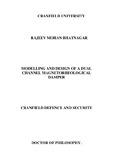JavaScript is disabled for your browser. Some features of this site may not work without it.
| dc.contributor.advisor | Hameed, Amer | |
| dc.contributor.advisor | Purdy, David J. | |
| dc.contributor.author | Bhatnagar, R. | |
| dc.date.accessioned | 2013-10-08T14:25:15Z | |
| dc.date.available | 2013-10-08T14:25:15Z | |
| dc.date.issued | 2013-10-08 | |
| dc.identifier.uri | http://dspace.lib.cranfield.ac.uk/handle/1826/8037 | |
| dc.description | © Cranfield University | en_UK |
| dc.description.abstract | A limitation with the current analytical models for predicting the performance of a magnetorheological (MR) damper is that they fail to capture the hysteretic variation of force versus velocity variation correctly. This can significantly underestimate the damper force and overestimate the dynamic range of the device. In this work a transient analytical fluid dynamics model is developed by using a combination of Laplace and Weber transform and Duhamel’s superposition of velocity boundary condition, to overcome these limitations. The solution of the system of nonlinear simultaneous equations, obtained by applying mass flow balance, velocity compatibility conditions and force equilibrium of Bingham plastic plug flow, gives the damper force. This method is shown to generate direct and inverse model of an MR device. The proposed model has been validated against a commercially available MR damper at low speed, to a range of test signals. The mean error using the above model has been shown to be 5% for all the test signals. This compares well with three conventional models which give; transient constant velocity model 35%, quasi static model 35% and phenomenological model 35%. The phenomenological model gives 10% mean error for a sinusoidal input signal. The application of the proposed analytical model has been demonstrated by the design of a novel dual channel damper. The design of the electromechanical components has been shown to be np-hard problem and the optimisation using genetic algorithm has been applied to minimise the volume and electrical time constant. The performance of the dual channel damper has been simulated for various combinations of values of shear yield stress for two channels. Compared to the conventional single channel damper the novel design is shown to give 30% higher damper force, 50% improved dynamic range and limits the effect of transients to within 10% of the damper force. The dual channel damper is an effective solution to resist the onset of turbulent flow in the channels up to 20m/s piston velocity. | en_UK |
| dc.subject | Dampers | en_UK |
| dc.title | Modelling and design of a dual channel magnetorheological damper | en_UK |
| dc.type | Thesis or dissertation | en_UK |
| dc.type.qualificationlevel | Doctoral | en_UK |
| dc.type.qualificationname | PhD | en_UK |
